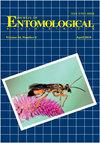Validation of Reference Genes Across Populations of Aphis glycines (Hemiptera: Aphididae) for RT-qPCR Analysis of Gene Expression Related to Pyrethroid Detoxification
IF 0.7
4区 农林科学
Q4 ENTOMOLOGY
引用次数: 0
Abstract
Abstract Metabolic detoxification is a common mechanism of insecticide resistance, in which detoxifying enzyme genes are overexpressed. Aphis glycines Matsumura (Hemiptera: Aphididae) is one of the major soybean pests in the United States and has developed resistance to pyrethroid insecticides after almost two decades of use. To date, there are no validated reference genes to normalize expression of detoxification genes for pyrethroid resistance in A. glycines. From a literature review, a list was compiled of genes from 36 gene families (68 sequences) frequently used as reference genes in gene expression analysis in Hemiptera. Exon–exon junction primers were designed for the best alignment matches to a draft A. glycines genome and were assayed in a three-phase screening. The first screen eliminated nonamplifying primers. The second screen used nine A. glycines populations varying in resistance to pyrethroids and eliminated primers with inconsistent amplification or low amplification efficiency, and quantitatively assessed the stability of expression in the 14 remaining candidates using NormFinder and a generalization of BestKeeper. The third screen quantitatively validated these results on the best candidates. Six genes were identified with the greatest stability across technical and biological replication and the nine populations. The genes identified as the most suitable reference genes for the study of detoxifying enzymes related to pyrethroid resistance in soybean aphid were: actin, RPL9 (ribosomal protein L9), RPS9 (ribosomal protein S9), AK (arginine kinase), RNAPol2 (RNA polymerase II), and RPL17 (ribosomal protein L17). Our findings will support studies related to insecticide resistance in A. glycines.大豆蚜(半翅目:蚜科)参考基因在拟除虫菊酯解毒相关基因表达的RT-qPCR分析中的验证
摘要代谢解毒是一种常见的杀虫剂抗性机制,其中解毒酶基因过表达。松村大豆蚜(半翅目:蚜科)是美国主要的大豆害虫之一,经过近20年的使用,对拟除虫菊酯类杀虫剂产生了耐药性。到目前为止,还没有经过验证的参考基因来规范大豆中拟除虫菊酯类抗性解毒基因的表达。根据文献综述,编制了一份来自36个基因家族(68个序列)的基因列表,这些基因经常被用作半翅目基因表达分析的参考基因。外显子-外显子连接引物被设计为与大豆甘氨酸基因组草案的最佳比对匹配,并在三阶段筛选中进行分析。第一次筛选消除了不符合要求的引物。第二次筛选使用了9个对拟除虫菊酯类抗性不同的甘氨酸A.glycines群体,并消除了扩增不一致或扩增效率低的引物,并使用NormFinder和BestKeeper的通用化定量评估了剩余14个候选中表达的稳定性。第三个屏幕对最佳候选人的这些结果进行了定量验证。在技术和生物复制以及九个群体中,有六个基因被鉴定出具有最大的稳定性。最适合研究大豆蚜对拟除虫菊酯抗性相关解毒酶的参考基因是:肌动蛋白、RPL9(核糖体蛋白L9)、RPS9(核糖体蛋白质S9)、AK(精氨酸激酶)、RNAPol2(RNA聚合酶II)和RPL17(核糖体蛋白L17)。我们的研究结果将支持有关甘氨酸对杀虫剂耐药性的研究。
本文章由计算机程序翻译,如有差异,请以英文原文为准。
求助全文
约1分钟内获得全文
求助全文
来源期刊
CiteScore
1.20
自引率
11.10%
发文量
40
审稿时长
>12 weeks
期刊介绍:
The Journal of Entomological Science (ISSN 0749-8004) is a peer-reviewed, scholarly journal that is published quarterly (January, April, July, and October) under the auspices of the Georgia Entomological Society in concert with Allen Press (Lawrence, Kansas). Manuscripts deemed acceptable for publication in the Journal report original research with insects and related arthropods or literature reviews offering foundations to innovative directions in entomological research

 求助内容:
求助内容: 应助结果提醒方式:
应助结果提醒方式:


